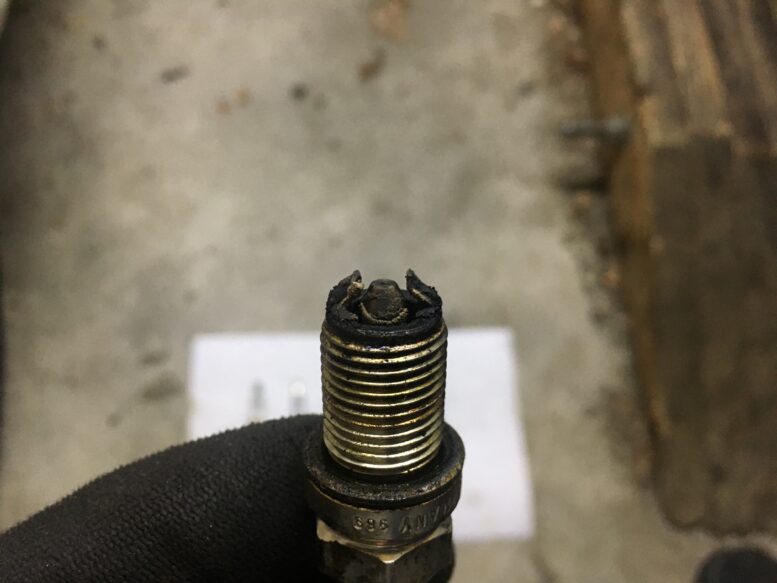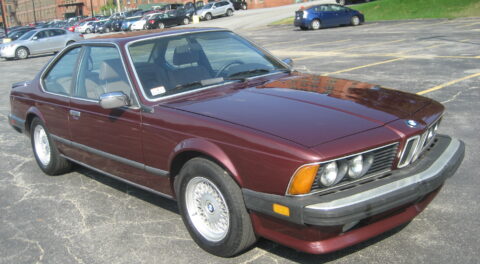Last week, I wrote about addressing an intermittent misfire in my daily-driver 2003 E39 530i stick sport that reared its head as cold weather rolled in, and how it resulted in my using my sister’s 2012 Honda Civic when the two of us needed to go to New York to visit an old friend, as I really didn’t want to be driving the E39 hundreds of miles if the misfire continued. I explained how my memory was that I recently replaced two stick coils, so now that the problem had recurred, I elected to change the rest of them. I wrote about how when I pulled the coils out, I saw that only one had a recent date code and how I located the other recent one in a box in the garage, but gunk on the bottom of the coil indicated that I’d installed it but pulled it back out for some reason I couldn’t recall (so much for my memory). This caused me to order another two stick coils so I could replace all six. Then, I realized that, while I had the car in the garage with the coils out, the smart move was to also replace the spark plugs (I couldn’t recall replacing them in the nearly eight years I’ve owned the car), so I added six new NKG 3199 plugs to the order and waited. I ended the piece by saying “The parts should arrive tomorrow. With six new stick coils and plugs, I’ll be pretty surprised if the misfire returns.”
Yeah, well, funny story…
Pulling the plugs was easy enough. As I mentioned last week, I first took care to use my compressor and an air gun to blow out any extraneous crud that fell into the deep plug recesses that most of these twin-cam coil-on-plug engines have. Then I hunted around to find a 5/8-inch plug socket for the narrow plugs these M52/M54 coil-on-plug engines use (the older M10 and M30 engines I’m accustomed to all use the larger 13/16-inch plugs). Then I found that I needed not only a 5/8-inch socket, but one that still had the internal rubber grommet intact that holds the plug securely in the socket, as the combination of the deep recess and the possibility of a dropped plug dislodging any residual dirt from the walls means that you want to lift each plug straight up and out. Using the grommeted socket and a long extension, I was able to do just that.
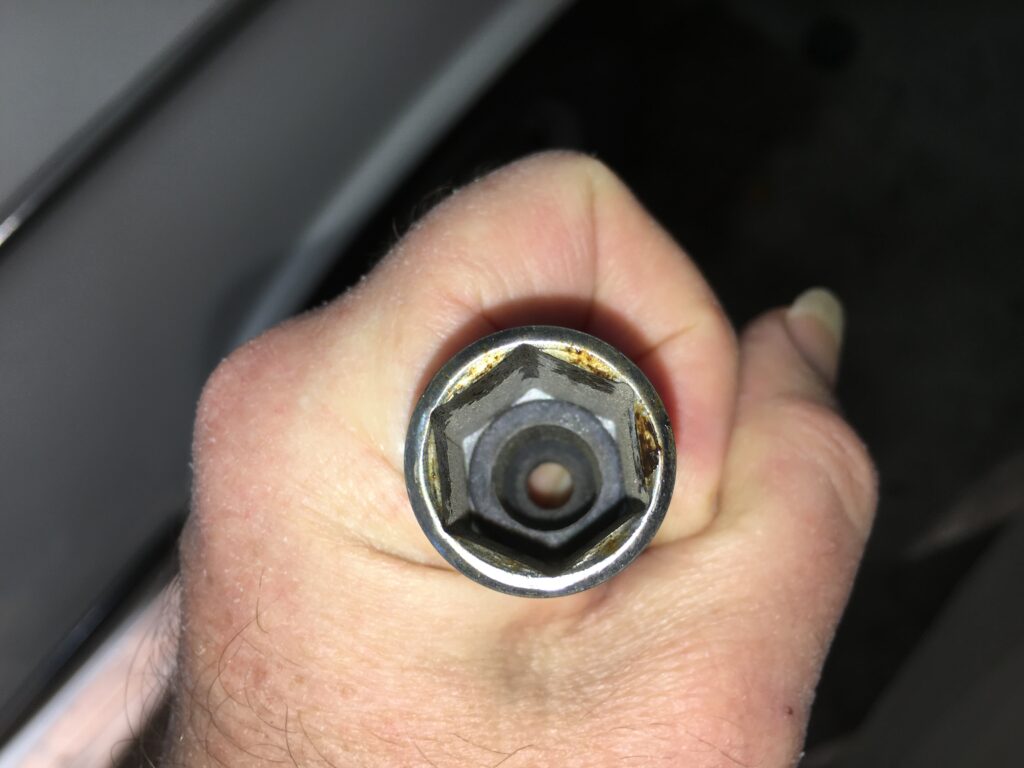
Rubber grommet? Check.
To my surprise, “pulling the plugs was easy enough” rapidly turned into “this is waaaaay too easy.” Only one plug seemed to offer any real resistance; the others seemed like they were barely tightened at all. All I could do was hold my breath and wait to see if the new plugs bit and snugged without evidence of the plug holes being stripped.
With all six plugs out, I examined them. Replacing them was clearly a good call, as they were all oily (I’d replaced the leaky valve cover last year) and their electrodes had clearly seen better days. But one thing stood out. Do you see it?
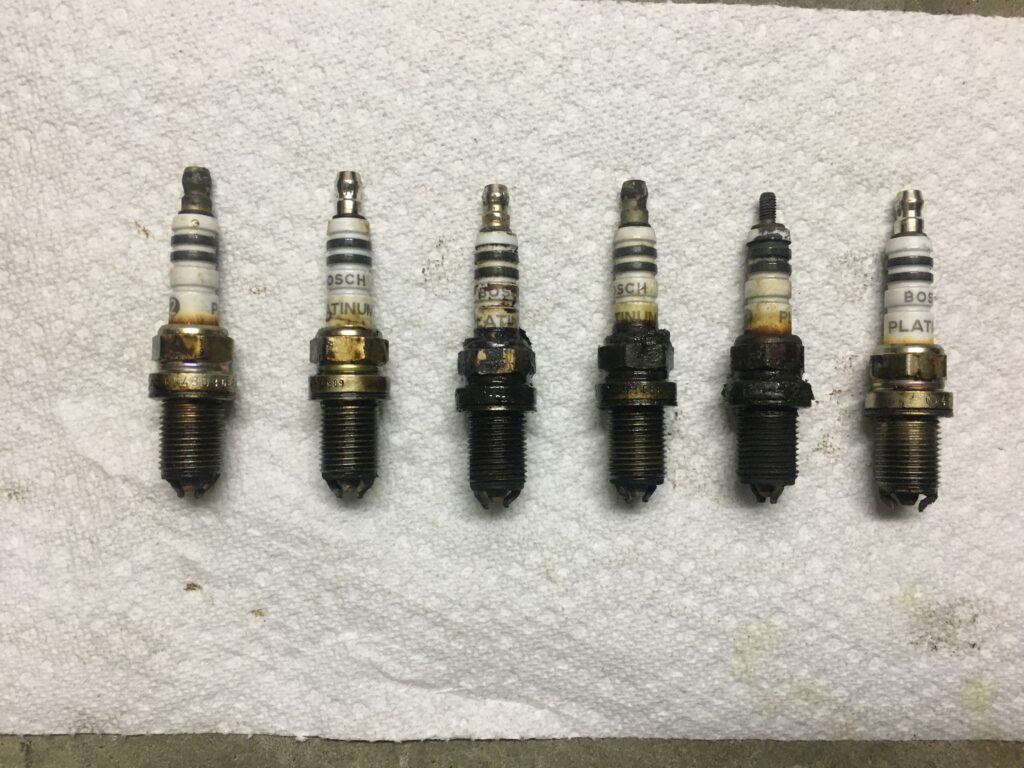
See anything alarming?
Plug #2—the second one from the right—was missing its little threaded-on terminal at the top. That terminal needs to be there for the stick coil to snap over it and make firm electrical contact.
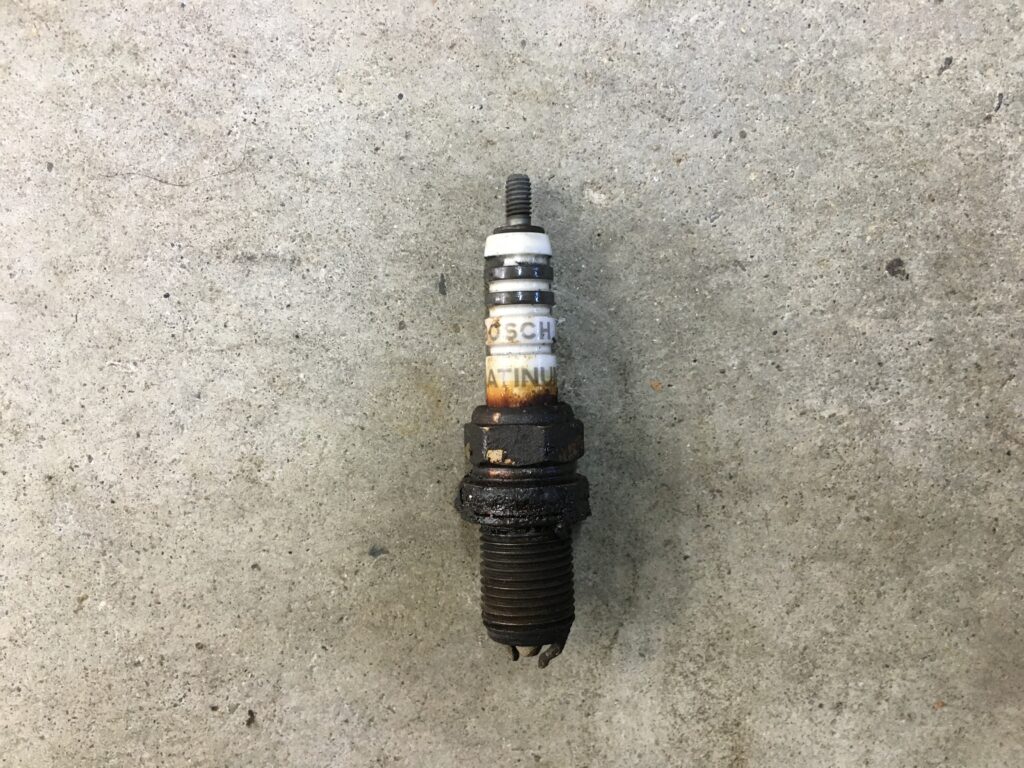
Yikes!
My first thought was “Well of course it’s misfiring.” However, as I’d mentioned last week, when I hooked up the code reader prior to pulling things apart, there were no active codes. Regardless, obviously I was happy that I’d made the call to order the plugs and leave the E39 in the garage for a few days while they and the other two coils were shipped (pressing the M Coupe into errand-running service wasn’t exactly hardship). And, also obviously, yes I shined a light down the plug recess and verified that the AWOL plug terminal wasn’t down there threatening to fall into the cylinder bore.
I hadn’t changed plugs in a coil-on-plug engine in quite a while, and I’d forgotten that there’s a little trick to it. I pressed the first plug into the grommet-equipped 5/8-inch socket, attached the long extension, carefully slid all three pieces straight down the plug hole recess, and tightened the plug in its threads, but when I tried to withdraw the extension and socket, I found that, due to the tightness of the grommet around the top of the plug, the socket stuck to it like taffy around your back molars, so when I lifted out the extension, it left the socket stuck on the plug. I tried pulling the socket up with a magnet, then a long pair of tweezers, but it wouldn’t budge. Finally I inserted the extension back into the socket, unscrewed the plug, carefully lifted everything back out, pulled the plug out of the socket, then slid only the very tip of the terminal into the grommet, just enough to hold it while I carefully maneuvered the plug down the hole, twisted the extension to spin the plug, and got the threads to catch. Then I lifted the extension and socket up and out. Once I used this method to put all six plugs in, I replaced the socket with another one without the rubber grommet, snugged the plugs down, then used a torque wrench to tighten them to the required 21 ft-lbs. Fortunately none of the threads were stripped.
With the six new plugs installed, I dropped the six brand new Bosch 00124/0221504464 stick coils into place, pushed them down until I could feel the little thock of the coils over the plug terminals, slid the electrical connectors on, and locked the tabs. I stood over my handiwork like an automotive Samuel L. Jackson mouthing “Misfire now, you little #@$%.”
The final step was the buttoning-up of the plastic components I’d pulled off. The coil cover (the false valve cover) went on first, then the fuel rail cover. I had a little surprise when I re-installed the box for the passenger-side cabin air filter. A piece of plastic had broken off the back of the housing, making it sit a little higher than it should. This in turn put pressure on the plastic tabs on the elbow piece that are supposed to twist-lock into the firewall, breaking two of them. I jumped on eBay and found that these pieces are plentiful and fairly inexpensive as used parts. For now I just put it back together the way it was, as it takes maybe ten seconds to remove both pieces.
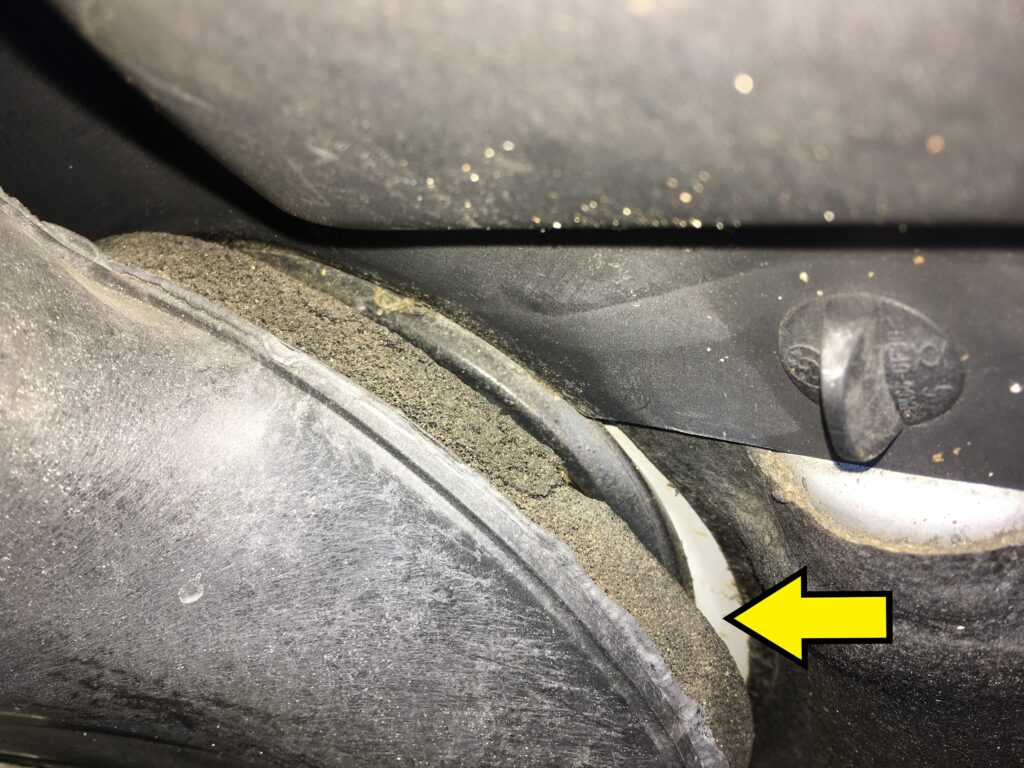
Engine compartment air may get into the cabin here.
And with that, I started the car and backed it out of the garage. The idle seemed a bit lower and rougher than it should. I didn’t think much of it, though, because with six new stick coils and plugs, it simply wasn’t possible that it could misfire.
A few seconds later, the Check Engine Light went on.
What the…?
I plugged in the code reader. It reported a misfire on cylinder #1.
#@$%!
I wondered whether I somehow hadn’t seated the connector to #1 coil and whether I should just pull things back apart and check, but at this point it was just a few days before my wife and I were hosting Thanksgiving for 23 and I had other more important things to do, like pick up the turkey, which I did in Hampton the ’73 2002, continuing the long tradition of taking one of the fun cars on this annual errand. (I also saw some presumably like-minded soul load a bird straight into the back of a Citroen DS21.)
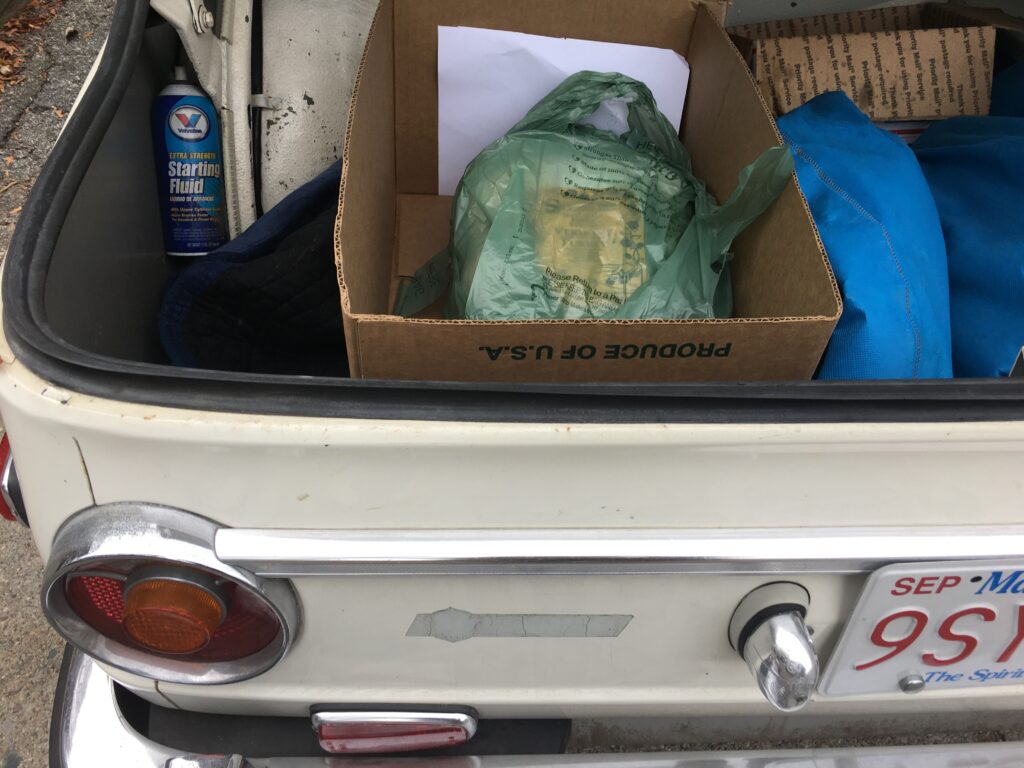
No, the starting fluid wasn’t for the turkey.
Over the next few days, I started the E39 every morning and evening when it was cold and the misfire was most likely to appear. As of this writing, it has not come back. Who knows. Sometimes car and component need to take a few moments to get acquainted. Whether it stays misfire-free still remains to be seen. But for a total of $182 in parts and a few hours of easy wrenching, it was money well spent.
On the plus side, the day before Thanksgiving when it was rainy out, I took the E39 to pick up the mashed potatoes, and for the very first time, used the remote trunk release I got working when I repaired the six broken wires in the trunk lid wiring harness a few weeks ago. One push of the button above my left knee, a glorious little pop, and the fellow in the raincoat loaded the spuds into the trunk.
So I am thankful for that.
—Rob Siegel
____________________________________
Rob’s newest book, The Best of The Hack Mechanic, is available here on Amazon, as are his seven other books. Signed copies can be ordered directly from Rob here.

